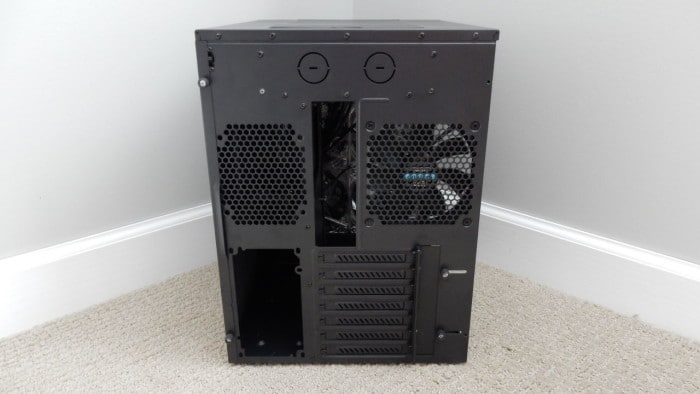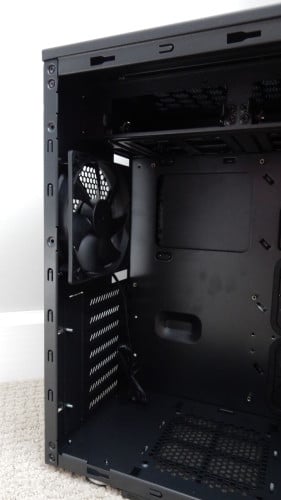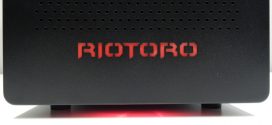introduction
Back in March of 2016, we took reviewed our first piece of hardware from Anidees, the AI8. That case proved to be a great contender for users requiring a large case, and had a great price point as well. Well, we are back today with another case from Anidees, the AI7. The Anidees AI7 is a dual-chamber ATX case that features a cube-like design that many manufacturers have been utilizing lately. The dual chambers work to separate the CPU and GPU from the PSU and storage devices. Follow along as we take a closer look at the Anidees AI7.

standout features
As with all products, there are a few standout features on the AI7 that we would like to cover. Without standout features to differentiate one product from another, we would live in a pretty boring world. Lets take a look at a few things that make the Anidees AI7 stand out from the crowd.
Lots of Cooling Options – Four(!) 120mm blue LED fans are pre-installed at the front of the case, and offer plenty of intake flow for the entire case. Being a cube design, these four fans help spread the intake flow across both chambers of the AI7. An additional 120mm fan is also installed at the rear of the case in the motherboard chamber. Two additional spots up top can be populated with 120mm fans, as well as a single spot on the bottom of the case. A 90mm fan can be installed above the PSU to add some additional exhaust flow to the case.
Plenty of Room – The AI7 supports multiple sizes of radiators up front, as well as the option of a top-mounted radiator. Extra long power supplies will have plenty of room to stretch out, and GPUs up to 348mm in length are supported.CPU coolers have 174mm of clearance to work with.
specifications
Available Color: Black
Material: Steel (0.7mm) / Plastic + Mesh bezel
Dimension (W / H / D): 288*380*380mm
Weight: 6.35 kg / 14 lbs
Motherboard Type: M-ITX, M-ATX, ATX
5.25” Drive Bay: 1
3.5” Hidden: 4
3.5” Exposed: 0
2.5” Drive Bay: 5 (4 from 3.5 HDD tray)
I/O Panel: USB3.0 *2,USB2.0 *2,Audio* 1,Mic *1
Expansion: 7
Cooling System:
- Front: 120mm blue led fan *4 (included) or 140mm fan*2 (optional) or 200mm fan*1 (optional)
- Rear: 120mm *1 (included), 90mm*1 (optional)
- Top: 140/120mm * 2 (optional)
- Bottom: 120mm fan*1(optional)
Power Supply: Standard ATX PS2 up to 200mm (optional)
Maximum Compatibility:
- Graphics Card Length: 348mm
- CPU Cooler Height: 174mm
- Cable rounting behind MB tray: 95mm
closer look
exterior
As we mentioned in our introduction, the Anidees AI7 takes on a cube-like design, which is pretty obvious when first taking a look at the case. The AI7 is available with or without a side-panel window, and comes in either black or white color schemes. A smaller Micro-ATX version of the AI7, the AI7m is also available, but features an altered layout and features. The AI7 itself is comprised of both steel and plastic, and has a pretty solid feel to it, without the extra weight often associated with steel cases.
The top of the front portion of the case features a single, 5.25″ external bay, flanked by the power and reset buttons, as well as power and disk LED indicators. Just below the drive bay are two USB 2.0 ports, two USB 3.0 ports, and headphone and microphone jacks.
Taking up a majority of the front of the case is a square mesh grille that allows the four included 120mm fans to pull in outside air and push it back across the installed components. Once the front facade has been removed, a dust filter can be accessed for easy cleaning.
The top of the case is quite plain, with just a single rectangular mesh grille taking up the middle section. The rear of the grille features a simple latch mechanism that can be used to “unlock” and remove the filter, providing access for easier component installation.
Once the grille has been removed, we get a peek at the mounting brackets that provide a variety of fan and radiator mounting options. There is a bit of front-to-back adjustment that can be made to the mounting brackets, which will be helpful when working with various radiator sizes. Below the brackets are the two upper 3.5″ drive bays and their associated drive trays. More on these later.
The left side panel of our case came equipped with a large window that takes up most of the side of the case. A small Anidees logo and brand name can be found towards the bottom right of the window. The right panel of the case is bare, except for a rectangular section of perforation used as an intake for the power supply. Both side panels are secured via two thumbscrews for easy access.
Out back we find two punch-outs for routing liquid cooling tubing to exterior components. The back of the case is where we also see the only real exterior proof (aside from the case window) of the dual-chamber design within the AI7. On the left-hand side is an empty grille area that supports a 92mm fan for additional exhaust duties. Just below that is the mounting location for the power supply. The power supply is mounted on its side, and takes advantage of the perforated side panel to pull in cool exterior air and pass it right out the back of the case. The right portion of the case features openings for the motherboard’s I/O ports and associated expansion cards. A single 120mm fan comes pre-installed to help keep hot air flowing out of the case.
The bottom of the AI7 features a pretty standard layout with four round feet with rubber pads to keep the case in place, as well as a removable filter to help keep clean the intake air from the optional bottom-mounted 120mm fan.
interior
After removing the sides from the AI7, we get a good look at the open layout within. The same black paint found on the exterior of the case can be found throughout the interior as well. The same black paint found on the exterior of the case can be seen within the AI7, and the inside surfaces are free of sharp corners. Rubber grommets are placed around the interior of the case to provide many cable routing options. Since the motherboard tray doesn’t completely divide the case into tow separate chambers, the option to run cables around the tray is also available.
The top section of the case can be configured to either house a liquid cooling radiator, or two 3.5″ drives. While we like this versatility, we would have loved to been able to do both at the same time. Also, if you choose to install a 5.25″ optical drive, one of the 3.5″ bays will become unavailable.
The front of the case comes equipped with four 120mm blue LED fans that are pre-wired to the included fan-speed controller, while the back of the case is populated with a single, non-LED, 120mm fan.
Flipping the case around to the right side gives us a look at the power supply mounting area, as well as the hinged 3.5″ drive compartment. This compartment utilizes a thumb screw to keep it in place, but can easily swing out to install drives via the included plastic, tool-less trays. Just behind the drive compartment is room for an optional 90mm fan for added exhaust duties.
When swung out from the rest of the case, the drive cage allows for easy drive installation and cable connections. The outside panel of the cage also allows for a 2.5″ drive to be mounted here by resting the drive on two pins that line up with the drive’s screw holes, and tow screws on the opposite side of the drive. With a case of this size, one might expect to see a few more drive mounting options, but we think five is probably plenty for most standard builds.
Taking a look at the right side panel of the case, we can see the removable dust filter for the power supply. This filter is held on via magnets for easy removal and maintenance.
installation
| Test Setup | |
| Case | Anidees AI7 |
| CPU | AMD Phenom II X4 975 BE |
| Motherboard | ASUS M4A88TD-V EVO/USB3 |
| Ram | PNY DDR3 1600, 8GB |
| CPU Cooler | Arctic Cooling Freezer 7 Pro |
| Storage Drives |
|
| GPU | ASUS ENGTX460 Direct CU |
| PSU | Corsair TX750W |
The installation of components in the Anidees AI7 was fairly straightforward. Most components installed in a standard manner, nothing special was encountered with our motherboard or graphics card. As shown below, there was plenty of space between the front fans and the motherboard and graphics card to do any extra cable routing needed.
While many of the current tower designs feature a separate compartment for the power supply, the AI7 is still a bit different from that mindset. We utilized a non-modular power supply for our build, so we were able to see just how much cabling room the case had during our installation. As you can see below, there was a decent amount of room available to store the power supply cables that we didn’t utilize in our build. A modular power supply will be able to provide much more free space in this area, which will help with overall case airflow.
The major difference in our installation was with the use of the drive cage on the power supply side of the case. We installed our 3.5″ drives in the included drive trays and slid them into the cage, latching them into place. We then swung the cage back into the case and secured it with the included thumb screw.
conclusion
Anidees has provided us with a roomy, well equipped case with the AI7. The short and stocky look is backed up with two separate chambers to assist with both case cooling, as well as component installation and cable management. A large window on the left side of the case gives system builders a chance to show off their rigs, and the four included 120mm fans with blue LED lighting will add a little light to the interior of the case.
Depending on the use-case of the AI7, the case may be a bit deceiving when it comes to storage options. While we appreciate the amount of working room available inside the AI7, we would have loved to see a few more internal 3.5″ drive mounting options, especially when you consider the fact that the upper drive options go away when that spot is used for liquid cooling.
Speaking of liquid cooling, with a little rearranging of the included fans, the AI7 supports a variety of radiator options. With the ability to fit three 240mm radiators, as well as a single 120mm radiator, all at the same time, we can’t imagine that not being enough cooling capacity for even the most extreme of builds.
While not overly flashy, save for the four LED fans, the AI7 is a good looking case that combines form with function. It checks off all the basic options of a current-day case, and even adds a few extras like the integrated fan controller, removable top grille, and multiple radiator mount points. The AI7 can be found on Newegg for $99USD. The non-window version is available there for just $89USD. Shoppers in the UK can check out Overclockers UK to get their hands on the AI7. Taking all of this into consideration, we have awarded the Anidees AI7 the Bjorn3D Seal of Approval.
| Anidees AI7 Pros |
Anidees AI7 Cons |
|
|
 Bjorn3D.com Bjorn3d.com – Satisfying Your Daily Tech Cravings Since 1996
Bjorn3D.com Bjorn3d.com – Satisfying Your Daily Tech Cravings Since 1996



























